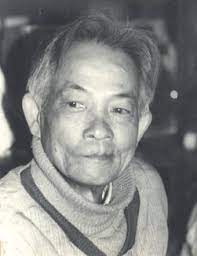
Duong Bich Lien (1924 – 1988). Gold Afternoon. 1962. Lacquer. 60×90 cm
In the Northern Vietnam, the climate full with four seasons — Spring, Summer, Autumn, and Winter — flow throughout the resounding life. The soothing seasons spread, interlace with one another during the change of foliages’ colour. From spring with humid drizzles, summer with warm sunny weather, autumn with fresh winds, to winter with staying next to a stove in stilt houses, sunlight flows with pulses of time. Sunshine at dawn and sunset has made poetry for Vietnam scenery.
In the “Gold Afternoon” lacquer painting, Dương Bích Liên had put a part of that charming poetry into it. A somewhat solitary village in the afternoon, the last weakening light rays suddenly glow stronger, dye trunks, leaves, and plain fields. It is like that the sunlight dye the calm landscape and then fade away. The last person carries rice home under the light of the sunset. Seizing that impressive specific short moment, Dương Bích Liên had set his heart into the painting.
With “Gold Afternoon”, Dương Bích Liên bravely creates and overcomes the gloss of the traditional decorative lacquer language. The author doesn’t use strokes and vermillion, but creates blurry shapes that almost look like oil though the gold’s monochrome limits the depth of art space. He wants to depict the atmosphere and real light with its effect in the space although lacquer paintings are familiar with the artisans’ artificial formula light. “Gold Afternoon” is a perfectly technical work, carefully drawn with each stroke, be in harmony with dear nature.
In “Gold Afternoon”, we see the cognition standstill about wondrous nature at the calmest time of the artist, the tropical nature that’s not scorching but sophisticated and clear. The muggy air in a cloudy afternoon appears and refracts beautiful light at the sunset. If sunrise shine on the sea is the present for Claude Monet and the Impressionists, then the sunset light shining on lakes, rivers, and fields flutters like a thin silky veil strip, contributes to the poetry of Vietnam scenery in the Northern countryside at sunrise, sunset.
A lot of painters portray the sunsets in the countryside after workday, some people with buffalos going home, others carrying rice and talking animatedly on the paths. The calls for chickens to return to cages, the sounds of children going back from school, the strong scent from pig’s feed pots. The sound rousing a corner of village appears in the pictures. Only Dương Bích Liên when capturing that inspiring short moment sets his heart into the painting.
Stopping on the field at twilight, the author watches the arrow of time, the farmers run with dusk. In the “Gold Afternoon”, he depicts the splendid and slightly regretful weakening sunset light to the landscape.
From romantic thoughts and feelings in front of the extremely fast change of light, the author created “Gold Afternoon” with deep loneliness and desolation of human life.
Lacquer is the language of golden age and luxurious majestic religion in centuries. Lacquer (the original name is “native paint”), board with calligraphy, parallel sentences, vermilion and gilding are obsolete when decorative aspect has been forgotten in Vietnamese pre-modern art.

Portrait of artist Dương Bích Liên (1924 – 1988)
Dương Bích Liên is an unusual Vietnamese painter who has always looked for desolated moments of reality in his works. The “Gold Afternoon” begins with the fact that the author overlooks the lacquer’s decorative lustre to sort out colours, brings the true art space to the picture.
On the black lacquer background where the author covers with radiant gold leaf, the light spreads the last time on deserted field at sunset. The bright constant colours which are drawn with blur strokes still make the gold afternoon scenery remarkable.
The picture has daring colour use and creates a new language for lacquer painting when the vermilion and gold leaf, fine craft element of the past are considered to be applied.
The art language in Dương Bích Liên “Gold Afternoon” has described that. The whole painting is not-glitter gold colour and blurry, builds perspective space. To break the vastly spreading yellow hue, the author lays an imposing, rugged ancient tree at best position with sparse branches and a far village in the composition. The clearest objects at the bottom right corner are two women packing rice and stuff up. All those details make the boundless field’s layout rigorous under the golden light of sunset. Small things like the ancient tree, the village, and the people don’t break the structure of the dreamlike beautiful landscape picture. The author way’s of forming has hints about space and time. “Gold Afternoon” shows us familiar space in the countryside, which has always been holding that nature gorgeousness for generations.
“Gold Afternoon” records the farmers’ frequent flowing timeline, the sunset or heavy rain, people still go home to gather round in family warm atmosphere, leave the field quiet.
“Gold Afternoon” is a traditional paniting, but Dương Bích Liên had found a new language when controlling the decorative strength and approaching to colour palette of modern arts to remain the light effect, colour, and painting on traditional lacquer.
Dương Bích Liên had depicted the atmosphere and real light of the sky in a gold afternoon. The 60×90 cm painting covered with sparkling gold seems to be dimmed by magical hand, the last fading light rays abruptly shines brightly on foliages, branches, village and field, brings viewers back to an accustomed gold afternoon in the past.
That’s a Vietnamese artist’s creative work painting the nature.
Photographer Le Vuong
Article by researcher Nguyen Hai Yen
Copyrights belong to Viet Art View







